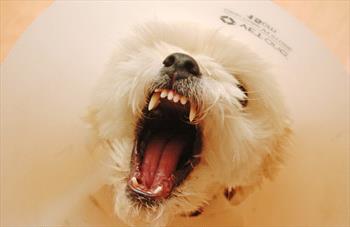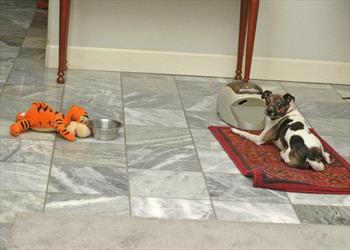Last time we looked at how to use a science-based approach (use of counterconditioning) to dealing with dogs with food bowl aggression and saw that by approaching the problems systematically the solution was pretty straightforward. So how do we tweak that approach to the case where the dog is food aggressive only towards other dogs?
For instance, “Puzzled in Pittsburg” writes,
I accidentally left my treat bag on the hill at a park with a friend and her dog went to sniff it. Rosco attacked him and made him bleed! Yesterday I was playing fetch by the water and another dog came by to investigate the toy I was throwing and Rosco attacked him (They had been playing together so nicely until I made the mistake of getting his throw toy out of the car).
As with the last example, we want to approach this in a systematic manner. Here are the questions that I generally ask myself:
- What he’s afraid of having stolen and by whom (people or other dogs).
- Then think, how can I help him to feel good about these people and dogs approaching his stuff (Classical counterconditioning). How can I make him feel that their approach predicts a jackpot of prizes for him?
- How can I do this safely so no-one is at risk?
- How do I know when he’s learning what I hope he is?
- How many people (or dogs) and situations should I practice in before I can completely trust him?
Compared to this, dealing with food bowl aggression towards people is easy because it’s easy to control the situation. So how to we control the situation when it relates to two dogs?
Once again, we’ll make sure we work on the leave-it exercise so Fido learns that the only way he gets food objects on the floor is to wait patiently. But besides this, we need to train him that when valuable food items are around and other dogs approach, the approaching dogs are no longer a threat, rather they are a cue that good things are about to happen. How will you do this safely and can you do it on your own? Because, realistically, how likely is it that the rest of the family will be there to help you on a regular basis? One way is using the Treat&train® remote controlled treat dispenser. First follow the program for training your possessive dog to lie down calmly on a rug using the Treat&train®, because doing so will really speed the possession aggression program up. Then once you’re through this short and simple training, you can start the possession aggression behavior modification.
Start with the possessive Fido lying down on the rug facing sideways to the direction in which you will have the practice dog approach.
The Treat&Train can be at the edge of the rug where you want Fido’s head. You will lay down treats or something else your Fido would normally be possessive over a couple of feet away from his head on the side that’s closest to the location from which the practice dog (such as Fido’s housemate) will approach. The treats can be in a bowl or plate. For safety’s sake, be sure Fido is tethered via leash to something stable so that if you make a mistake and he leaps towards the item he would normally guard he can’t reach the practice dog you’re using in training. Also make sure that the Treat&train has yummy rewards that are as tasty or tastier than the treats that are on the ground.
Now you’re ready for the first session. Start with the practice dog across the room and ideally visually out of sight behind a chair or counter (or even just outside the room). Then walk out from behind the visual barrier and approach Fido. As soon Fido sees the practice dog, dispense treats from the Treat&Train continuously (every 1–3 seconds) so that he associates the appearance and approach of the practice dog with yummy treats. Only approach to a distance where you know that Fido will remain focused only on the food rewards from the Treat&train rather than turning towards the practice dog out of concern that the practice dog will take the treats that are lying on the floor. Then within 5–10 seconds of starting to approach, turn around and walk away to head back behind the visual barrier. As you walk away, stop dispensing treats from the Treat&Train. Repeat this step at least 3–5 times to the same distance successfully before you decide to start moving a little closer. Practice in short sessions (5 minutes) and always stay below the threshold where Fido might act possessive (e.g. hovers over the food item that is on the plate that the practice dog is approaching). Wait behind the visual barrier for at least 5–10 seconds so that Fido has plenty of time to wonder what makes the treats dispense—“Oh approach of another dog towards my treats causes the Treat&Train to give me treats.”
If you’re doing this correctly, then within several sessions, as soon as Fido sees the practice dog approaching him and the treats on the ground, he should turn away from the treats on the ground and look at the Treat&Train expectantly. This tells you that he understands that the other dog’s approach towards his valued item is a cue that he’ll get even better treats from the Treat&Train, so he need not be possessive.
Once Fido showing signs that he thinks the practice dog’s approach towards his treats brings him great luck and even more treats from the Treat&train, you can work closer to him (but still out of leash range). Systematically approach more closely or spend more time in the area of the plate with treats or have the practice dog move around more excitedly in the area of the treats (but make sure Fido doesn’t have to worry that the practice dog will jump or step on him since that could scare or hurt Fido and cause him to regress). Even get to the stage where the practice dog eat the treats that are on the plate.
Once you repeatedly find that Fido no longer cares about the practice dog approaching the food item, you can practice in slightly different situations—Different rooms, different practice dogs, outside instead of inside.
You can also switch to doing this with 2 people where one person handles the practice dog and the other gives treats to Fido instead of using a Treat&Train. Then, it’s important to be sure that if you’re not sure how Fido act in a real life situation, always be ready to counter-condition (change his emotional state and his feelings of possessiveness in that situation) by getting his attention and giving treats while the other dog approaches and then repeat until you know Fido consistently looks to you (or the Treat&Train) for his reward instead of acting possessive. And remember to pair this with a really good leave-it that means, “Hey if you come over here you’ll get something way better and maybe even get the treasured item too, but only on my cue.”
So, that’s it for case 2: the dog who is possessive of his food bowl with other dogs. Can you go back and see how we considered all of these questions in our plan?
- What he’s afraid of having stolen and by whom (people or other dogs)
- Then think, how can I help him to feel good about these people and dogs approaching his stuff (Classical counterconditioning). How can I make him feel that their approach predicts a jackpot of prizes for him?
- How can I do this safely so no-one is at risk.
- How do I know when he’s learning what I hope he is?
- How many dogs and situations should I practice in before I can completely trust him?
Ok now it’s your turn. What if you have a dog who is possessive when dogs come up to you because he’s guarding for your attention or guarding you because you have the bait bag? And what if that dog is the other dog in your household? Submit your suggestions below while trying to make sure you cover the questions 1–5 listed above. We’ll give you the answer in part 3 of this blog!





